As an Amazon Associate Playpedalsteel.com earns from qualifying purchases. This page contains affiliate links.
The pedal steel has many expressive capabilities, and how you speak through the instrument will be greatly affected by the way you use a bar.
Since you use it for vibrato, “fretting notes,” and even slides, the bar plays an important role in voicing notes on the pedal steel.
It’s important to find a bar that is comfortable in your hands and that you enjoy using. Consider how much the bar weighs, its length and diameter, and how it feels against the strings…
Bar Pressure: Weight and Size
When playing pedal steel, it can be beneficial to think about the amount of pressure the bar is producing on the strings.
A bar’s weight and size can greatly affect this, along with how much pressure you physically apply with your hand.
Smaller Bars – 2.75″x.75″ (4.5 oz)
If you plan on doing more slides on the neck, or moving quickly between positions, you might like the lighter feel of bars that are about 2.75″ by .75″ in size.
Sometimes lighter bars like this are great to use if you’re playing a lot of harmonized sixths on the 3rd and 5th strings of the E9 neck.
Combined with the use of the A and B pedals on these strings, the lightness of the bar can be used really expressively for accentuating glissandos and vibrato.
It works particularly well with this playing technique because of the smaller gauge sizes of the 3rd and 5th strings too. The Dunlop 919 (link to Amazon) is a good bar to use for this type of playing.
If you’re interested in using a higher-end .75″ bar, then check out BJS Bars’ options for this size. BJS makes some great quality bars, that are worth investing in if you plan on playing steel guitar for awhile. Most BJS bars will have a smoother feel against the strings compared to other bars, have a nice tone to them, and good overall playability.
Medium Bars – 3.25″x.875″ (7.5 oz)
Bars that are closer to 3.25″ x .875″ in size can be effective “all-around” bars to use – they’ll give you enough weight to put solid pressure on the strings, and they will be long enough to cover a good amount of strings.
Also, if you plan on doing a lot of bar movement, it may be nicer to have a bar that is more agile in motion compared to the heavier and longer ones.
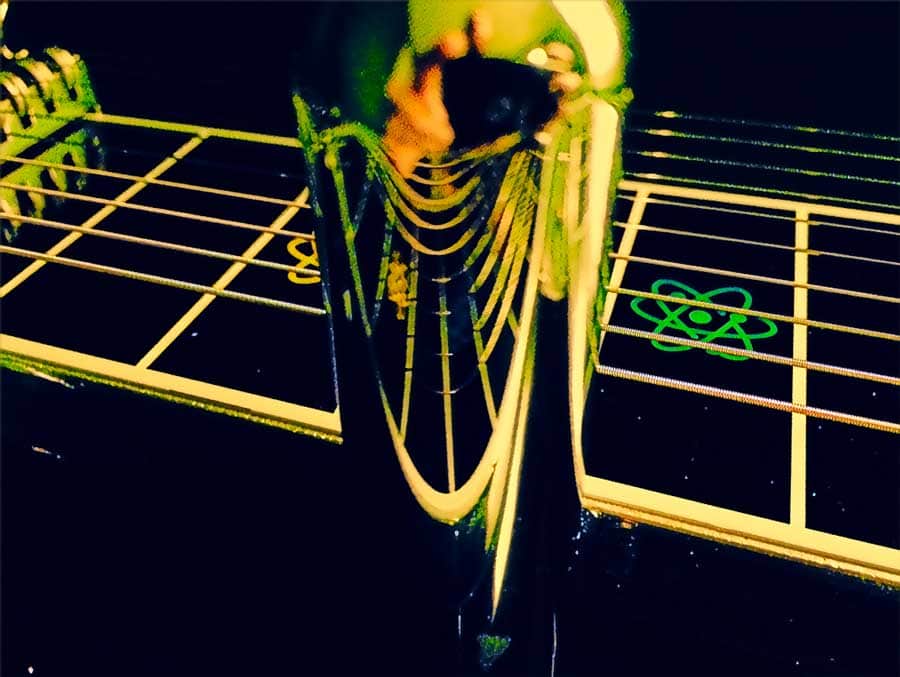
Bars around this size still lean towards the larger size, so keep in mind that there are also smaller bar options to achieve similar playing uses.
Medium-sized bars like Dunlop’s 920 (link to Amazon) can be good all-around bars to use, and you can always move to a smaller or larger bar if you find that you prefer a different size. Also, check out the BJS bars in this size range if you’re looking to invest long-term in a steel guitar bar, or have a higher performance one.
Larger Bars – 3.75″x1″ (11.8 oz)
Oftentimes, larger and heavier bars can provide a warm and bold tone, as they give plenty of force to create a nice full sound.
Using a larger size bar can also be beneficial if you intend to cover a wider range of strings at one time while playing, especially if you play a 12-string pedal steel.
For instance, if you plan on playing a chord voicing that incorporates strings 9 and 1 at the same time, then the length of this may help with reach.
These types of bars can also be beneficial if you have large hands, or are looking for a bar that may feel more comfortable than some of the smaller ones.
Make sure your hands are large enough to effectively and comfortably use it though. If they are, they’re usually nice ones to have in the steel seat for different playing occasions. Check out Dunlop’s 921 Stainless Steel Bar (link to Amazon), which is a good 3.75″x1″ bar to use for pedal steel. Here are the 1″ options from BJS Bars.
Keep in mind, when using a larger bar, that you will possibly lose some of the mobility and agility that lighter bars provide when moving between positions on the neck.
This type of bar can be a nice option to have for slow tempo ballads or waltzes, where you’re not doing a lot of quick bar movement, and you’d like to change your tone for that particular song.
Bar Material: The Contact Surface
It can be helpful to think about the type of bar you’d like to use – how will it feel against the strings? What material the bar is made out of can affect many things.

Stainless steel, chrome-plated, glass, and other types of bars all have different tonal effects on your sound.
A chromed brass tone bar like Dunlop’s 928 (link to Amazon) will often have a warmer sound than a stainless steel bar. Glass bars and slides usually have a smooth, silky warmth to them, especially when used with a tube amp.
Stainless steel can be a great material to use for pedal steel too, as it will often provide enough brightness and clarity for a genuine and traditional sound.
Bar Control for Steel Guitar
Controlling the bar enables a steel guitar player to make many unique sounds that otherwise couldn’t be made. By moving the bar up and down the length of the strings, while applying force to them, you can raise or lower the pitches of the notes.
Also, moving the bar in a position produces vibrato, similar to that of a singer’s voice. Below is more about bar control technique for steel guitar…
How To Control the Bar: The Five Essential Ingredients
What is Bar Control?
Controlling the bar involves using your left hand to create a downward force against the strings. By moving the bar up and down the length of the strings with this force, you can raise or lower the pitches of the notes, as well as do various other things.
This can include moving the bar more slightly in a position to produce vibrato, similar to that of a singer’s voice. You can also control the bar to make slides into or out of notes, which is also similar to the human singing voice.
Slides using this style of playing resemble slide guitar techniques that are more commonly heard in blues and rock n’ roll idioms. Sacred steel guitar also makes common use of slides to emote various sounds and musical expressions.
Controlling the bar enables you to make many unique sounds that otherwise couldn’t be made.
The Basics of Bar Control
How to Hold the Bar
Holding the bar in the left hand, resting between the index and middle fingers when the palm is open, often initially controls the bar.
When playing, you have your palm facing down while holding the bar in the same manner, but with the support of the thumb.
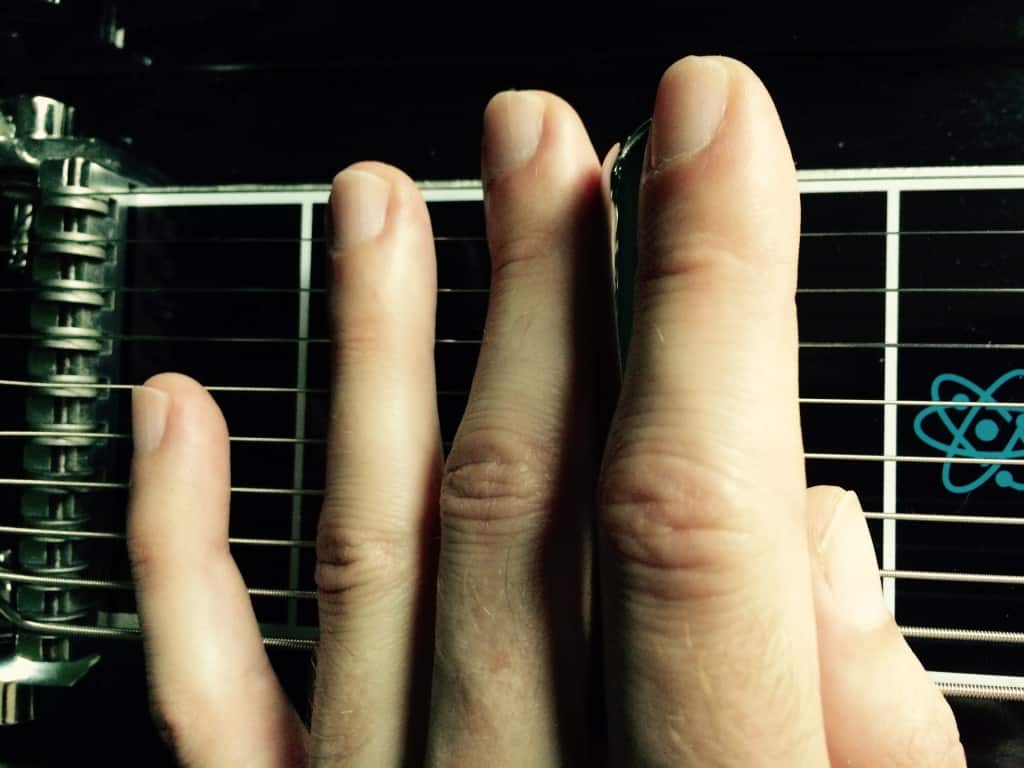
Moving The Bar
Moving the bar horizontally, to move between various fret positions, requires you to move the bar rather quickly, and have it stop at the intended position. This is one of the most challenging aspects of pedal steel bar control.
Using the Bar
By exerting pressure on top of the bar with the index and middle finger (index mostly), downwards on the strings, you essentially “fret” the notes.
You usually dampen, or mute the strings behind the bar (between bar and roller nut) with your left hand’s ring and/or pinky fingers.
How To Control the Bar: The Five Essential Ingredients
When practicing bar control, there are numerous aspects at play that you can keep in mind. These different parts combine to make up how you control the bar, and what the resulting sound is.
Below are some various parts of controlling the bar, which I call “The Five Essential Ingredients”, and can be studied during practice.
Moving Between Positions and Stopping at Them
Getting the bar to the correct position requires you to move it rather quickly sometimes, as moving to various positions is an important part of bar control.
Even though a lot can be played in just one position of the fretboard (especially with the convenience of pedals), keep in mind that steel guitar was born in a tradition of controlling the bar and using it to emit many sounds in many positions.
After all, before pedals were added to the steel guitar, a player had to use bar slants and move the bar more frequently. Overall, they had to have a deep understanding of controlling the bar. They had to really know how it can manipulate the notes and strings.
How To Move Between Positions
To get to the desired position, you move the bar horizontally in a rather quick manner, and stop it at the position.
This can involve moving it up a fret or back one fret, or a few, or even larger movements of several frets. Some players are even able to move it 12 frets or more, accurately, in split seconds.
When moving between positions, most of the time you do not lift or pick the bar up and remove it from the strings. This may yield unwanted tones, and possibly reduce bar accuracy and efficiency.
Moving the bar “up” frets means moving it horizontally to your right, while moving it “down” frets means moving it horizontally to your left.
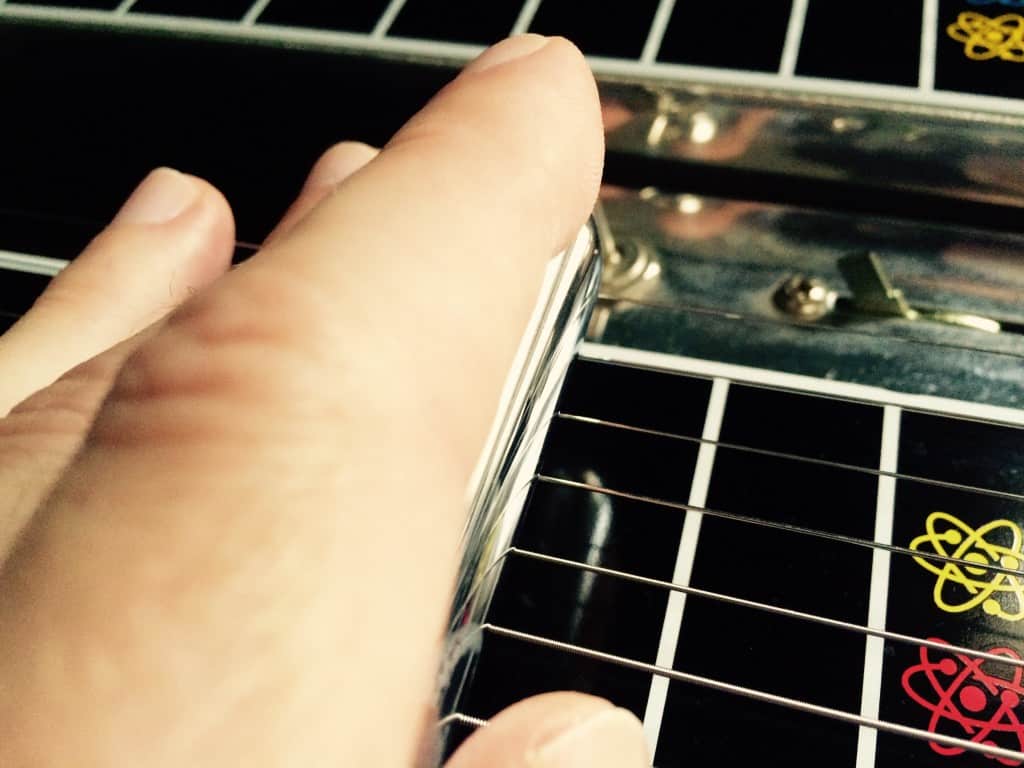
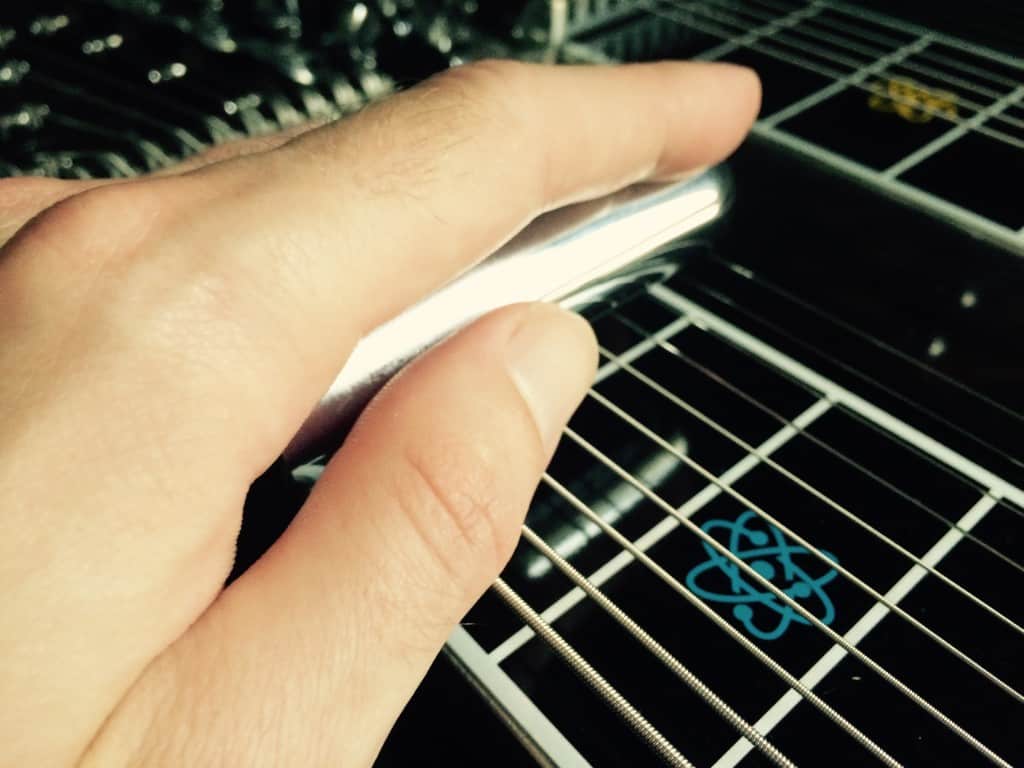
The Physical Movements
To make these movements between frets, and to practice them, requires a physical exertion of the left arm and shoulder that can be built upon and strengthened. The pedal steel is a physical instrument, and moving the bar between positions is no different.
I would say this is one of the most physical techniques involved with steel guitar playing, and working on improving it from the get-go will help you in the long run.
There are various practice exercises that can train you for controlling the bar, and help you realize the physical and musical aspects to it.
It is often a good idea to begin working on smaller movements between fret positions, like one or two frets, then progress to larger ones. It is easier to jump off the shorter diving board at first, and then progress to the high dive.
Build accuracy and precision as a foundation, and then grow from there. Try to work on moving one, two, or three frets at a time, up and back the fretboard, then try out larger movements once this is somewhat under control.
Dampening Behind The Bar
You usually lightly dampen, or mute the strings behind the bar (between bar and roller nut) with your left hand’s ring and/or pinky fingers.
When moving between positions, it can help to “lighten” the pressure of this dampening even more, so that movement becomes more fluid, and can be quicker and more efficient.

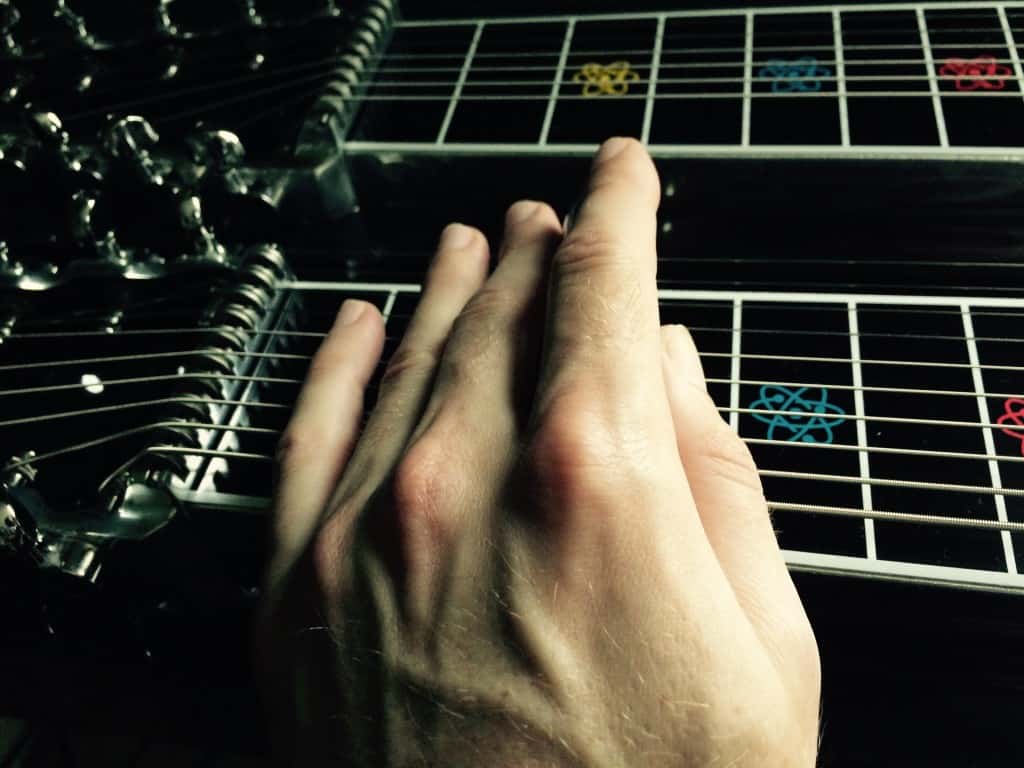
It may help to think of bar control, and the movement between positions, as a very athletic activity. You can view moving between these positions, or frets, as physical lengths or distances — try to learn what moving the bar three frets entails physically, or any fret length/amount (seven frets for example).
This is akin to a basketball player, who understands the difference in physics between shooting a free throw, three-pointer, layup, and anything in between if they want to make shots consistently from any range or distance. They have to practice and work on these different shots often to yield results.
We aren’t much different as steel players, and thinking of steel practice as a sport can sometimes help in relating to technique and the practice of developing it.
Keeping the Bar Straight When In Position
Unless you are intentionally slanting the bar to achieve a desired interval, or to adjust slightly for major thirds and certain chord inversions, the bar is usually kept straight when in a position.
This straightness is the same straightness of the fret lines; when straight in a position the bar is usually parallel to these lines or markers. This will entail accurate intonation, control of the bar for vibrato, as well as peace of mind.
When moving the bar between positions, the bar is often kept as straight as possible so that no extra movement is needed when it lands in position. This is efficient, and utilizes physics to your advantage.

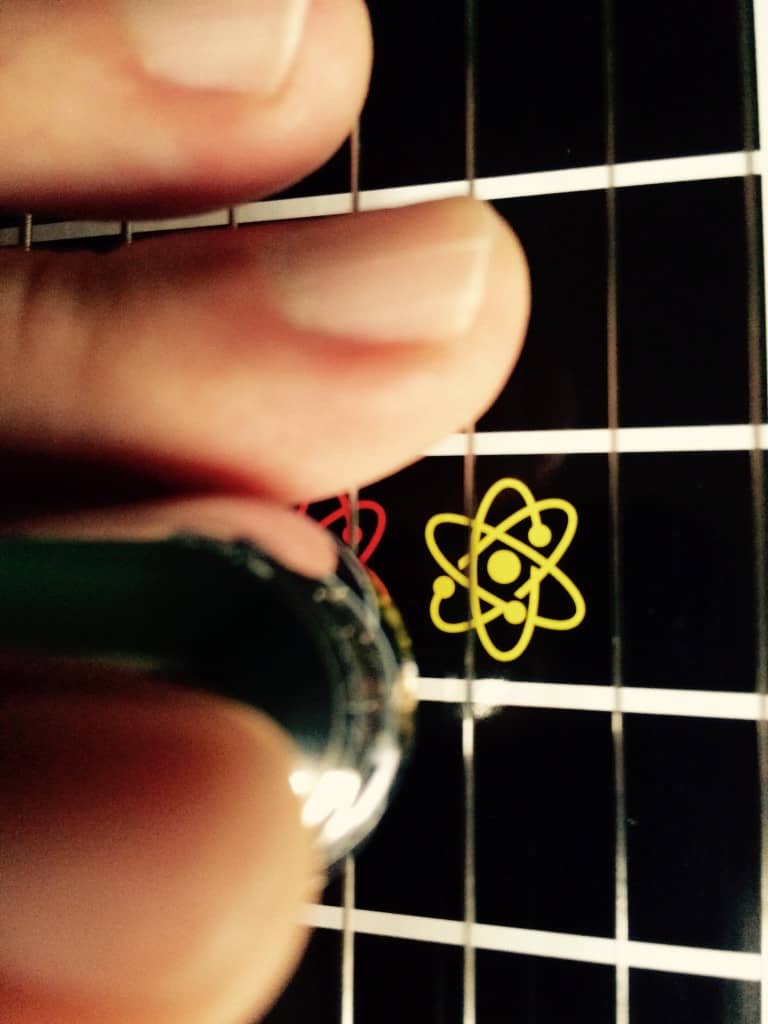
Covering the Intended Strings on a Steel Guitar
A player doesn’t necessarily need to cover all 10 strings (12 for universal tunings) of the pedal steel guitar with the bar, at all times. You can save energy, and maximize efficiency, by only covering the needed strings and string groups that are being played at that time.
For instance, if you’re only playing strings 10, 8, and 6 for a couple of measures, then it is not necessary to have the bar covering strings 4,3,2, and 1 at that time too. These strings (4,3,2,1) will still need to be dampened or muted somehow though, whether with the picking hand, or the extra length of the middle finger on the bar hand.
You can cover certain strings in this manner, by moving the bar forwards and backwards in relation to your body. A bar that is around 3 inches in length can often be a nice size for covering enough strings and string groups, such as Dunlop’s 920 bar (click to view on Amazon).
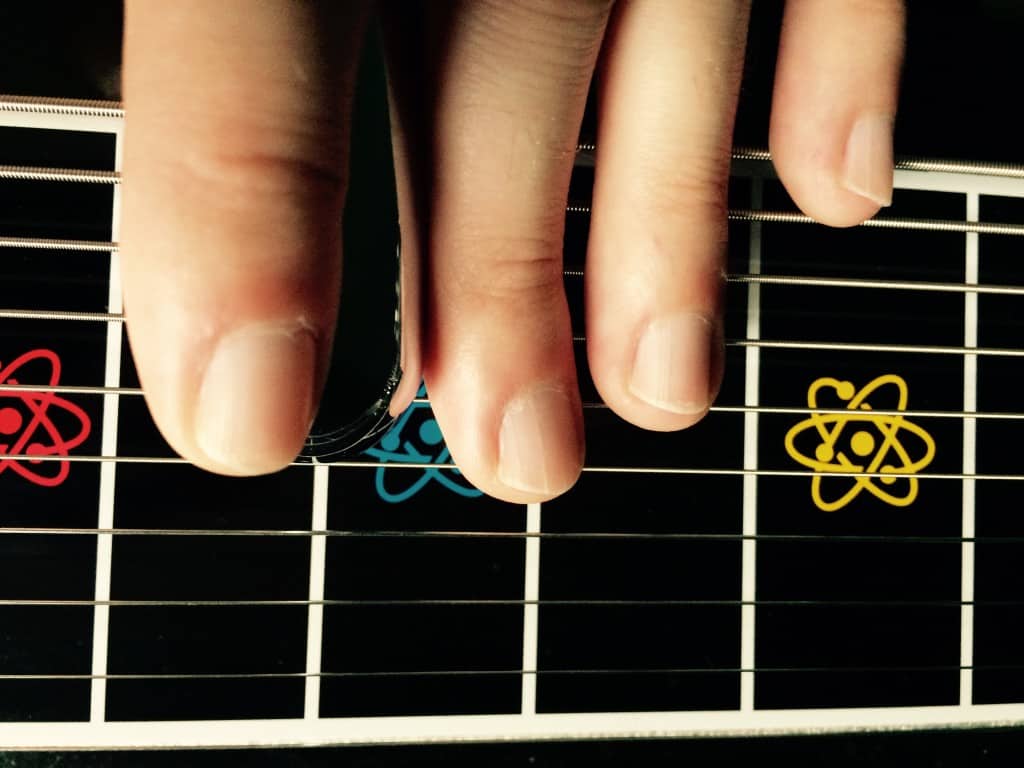
Bar Pressure for Steel Guitar
When you put bar pressure against the strings to sustain notes, you usually do so with an equal force on all the strings being sounded.
This entails keeping equilibrium and balance in mind; in other words, it is usually a good idea not to push too hard on the nose of the bar, or too hard on the heel of the bar (certain styles of playing or music may benefit from adjustments to this though!).
To create a good equilibrium, as well as a good amount of pressure downward on the strings, usually you will push the bar down in an area closer to the nose-half of the bar.
For equilibrium, you can balance or stabilize this by using the rest of the index finger, and some of the thumb and middle finger, to create a balanced pressure throughout the length of the bar.
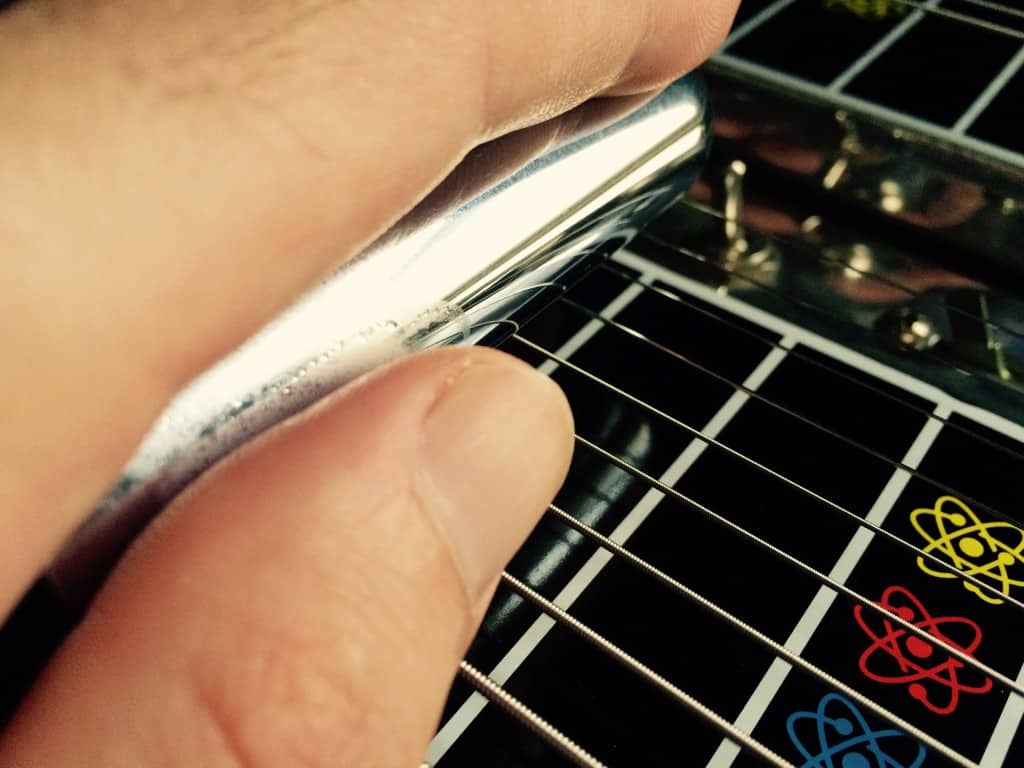
The Amount of Pressure on the Bar, Against the Strings
A suitable amount of bar pressure, or the amount of force you push downward on the strings, will be enough so that the strings don’t buzz, and not too much where you raise the pitch excessively and mess with your intonation.
You want to find a balance between pushing hard enough so that the strings can sustain for a long duration if you want them to, but not so hard that the steel guitar can’t stay in tune with the music, or itself.
It is usually a good idea to be graceful, but don’t be afraid to use enough force to get good sustain from the instrument.
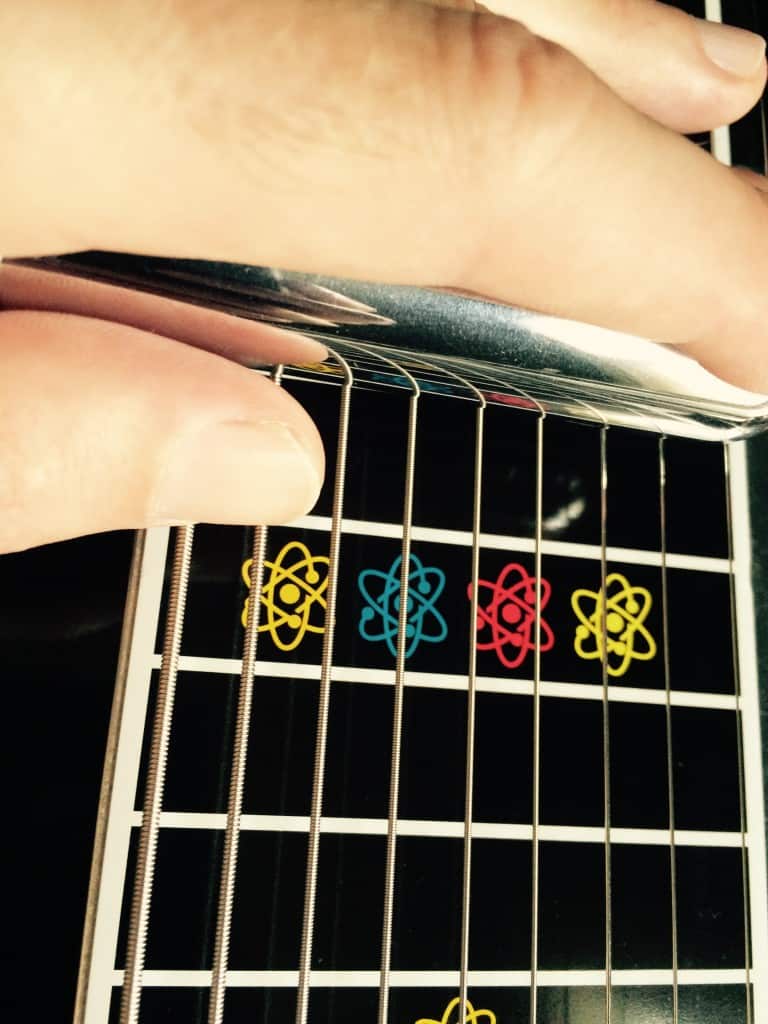
Vibrato for Steel Guitar
The vibrato of the bar, and the control/motion used to create it, is perhaps the most expressive and unique feature of bar control and steel guitar playing.
Each player has such a unique vibrato that is ingrained in his or her tone; this makes it a large part of the steel player’s character and voice. Similarities, and patterns, can be found within their techniques though.
Creating the Desired Vibrato Effect
Common starting points for vibrato expression begin with 1) shaking the bar back and forth more linearly, or 2) stirring and rolling the bar in a more circular, rounded motion.
Many times these styles or types of vibrato overlap to create more possibilities.
1) Shaking the bar in a more linear fashion will often give the vibrato a more excited, rock n roll, and edgy tone. Using a cutaway bar like Shubb’s RR1 Bar (link to Amazon) can be a great way to accentuate this kind of vibrato tone.
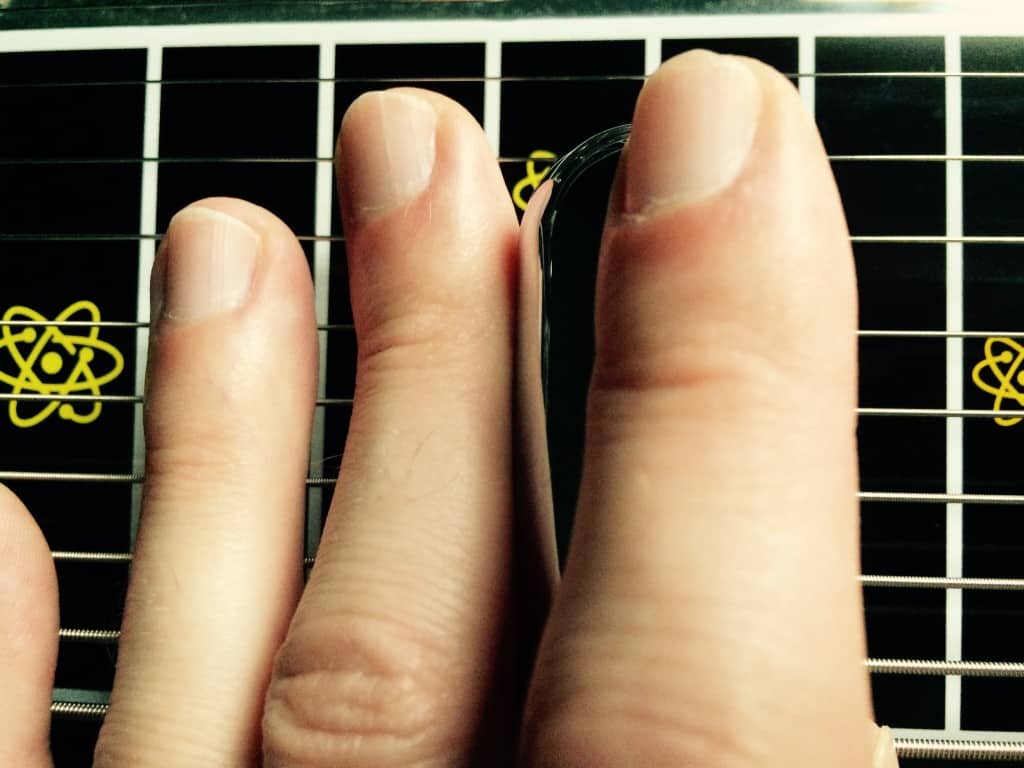
2) Rolling or stirring the bar in a more circular motion can give the vibrato a warmer, smoother, rounded sound. Usually round bars are easier to use for creating this type of vibrato, however any type of bar is often capable of voicing either type of vibrato.
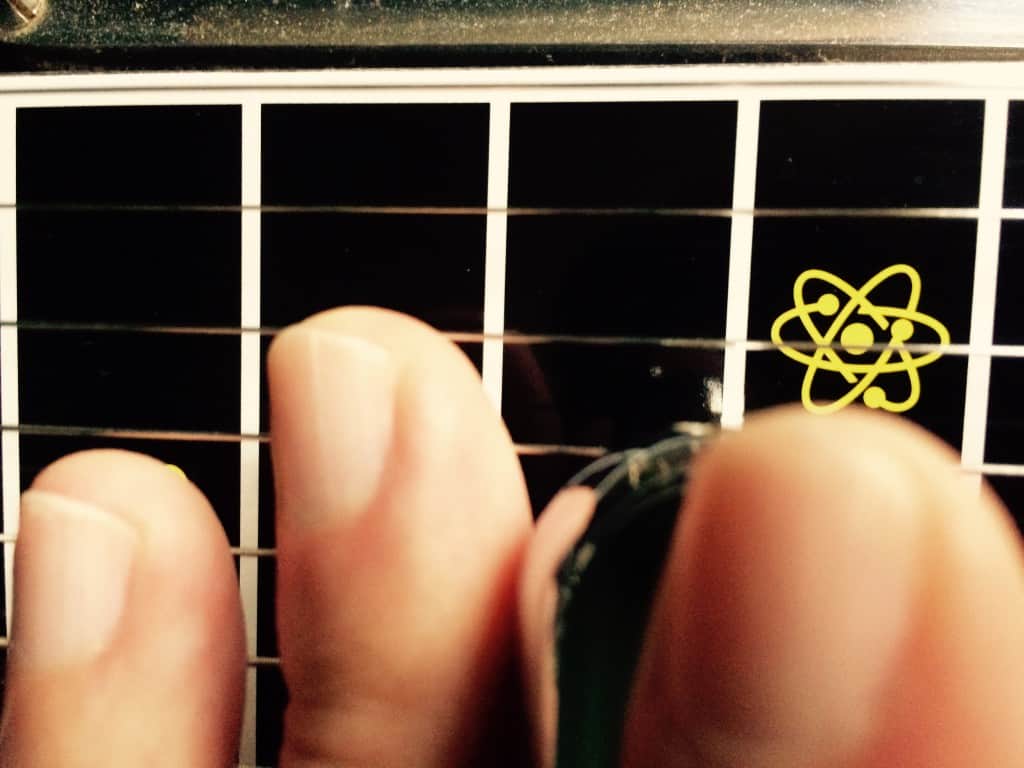
Try experimenting with both types of vibrato to develop your technique. Most pedal steel players use round nose bars for playing, however there are many kinds of music that benefit from cutaway bars.
I use a round nose bar for an assortment of musical styles, and find that it is definitely capable of producing both types of vibrato, or even a mixture. However, I enjoy the advantages and sound I get from cutaway bars for many forms of music and playing situations too.
Eventually, you probably won’t need to think about your vibrato types/technique while you play, you’ll play what feels right at that time, as an extension of your steel voice.
The goal is to understand intuitively how to manipulate the bar while reacting to the music. Know how and why you are using your vibrato at any certain point, but try to abandon thought for feel.
The distance and speed of left to right movement of the bar are the two main physical principles behind the vibrato. These have countless combinations, which is why no two steel voices are the same.
The tasteful use of a palette of vibrato tones, sounds, and textures makes a steel player an interesting character with a story to tell.

Bar Shape, Application, and Vibrato
Bars can have different shapes and applications – what instrument it is designed for can be a determinant in this.
When buying a bar, you’ll also want to think about the way vibrato is used. Different bars can affect the way vibrato is applied and expressed through the strings.
Most pedal steel bars are designed with round noses, while many dobro and even lap steel bars have cutaway sides.
Some pedal steel players, especially if they’re utilizing a lot of slides and fast bar movement, will use cutaway bars like Shubb’s RR2 (link to Amazon).
This type of bar is great for playing blues, rock, or up-tempo tunes – use some distortion, and quicker slides, to help in getting a tone similar to bottleneck slide guitar playing.
Cutaway bars can also change or influence the way various vibrato techniques can be applied. If you’re used to round nose bars, and want to have more bar options in your steel seat, then I recommend trying a cutaway.
They can be great for working on slide techniques, which can help you gain more capabilities for expression with your bar use.
These bars can be real melodic, and can emulate singers’ voices when used with a certain vibrato. Another good cutaway bar to check out is Dunlop’s 926 Tonebar (link to Amazon).
Comfort in Your Hand
When choosing the size and weight of your bar, a great place to start is to consider how comfortable it feels in your hand.
If the bar doesn’t feel comfortable in your hand, you may have a tougher time controlling it while playing. This can impact your sound from a technique standpoint.
Think about the size of your hand and fingers, as well as your dexterity. Try to find one that feels comfortable resting between your index and middle fingers while your palm is face up.
Also, consider its length in this position. It can be a good idea to use a bar that is slightly longer than your index finger while in the playing position.
If the bar is slightly longer than your index finger, but not too short or long in general, then you’ll likely have better control over it when pushing downward against the strings.
This will also affect the control you have over the bar when moving between various positions along the neck.
It’s Always Nice To Have Options
Many times you’ll find that having a few bars can be nice. I like having one to primarily use, another one that is a backup in case I lose or damage my main one, and also a bar for special techniques or sound effects.
Here are three bars I recommend that would be a nice combination to have in many playing situations:
- BJS .875″ Bar (for 10 String Steel Guitar) – This bar is great for most of your pedal steel playing, as it will be heavy enough to produce a solid tone, and lengthwise will cover enough strings for a lot of your playing.
- Dunlop 920 Stainless Steel Tonebar (available on Amazon) – Because of its reasonable price, this bar can be nice to use in case you ever needed a quick go-to bar, and would be a handy backup to have in your steel seat.
- Shubb RR1 (available on Amazon) – If you like to play rock, blues, or own a tube amp, this bar can be enjoyable and useful. It is great to use for slides, and if you use it with distortion or a tube amp, it will help in getting a tone that is often associated with rock and blues sounds.
Conclusion
A lot of your playing and technique will influence your sound – your hands and ears will ultimately determine your tone most of the time.
However, using a bar is one of the most enjoyable parts of playing pedal steel, and will greatly affect how you voice yourself through the instrument.
Thanks for checking out this page, hope it is helpful and makes playing more enjoyable! If you’re interested in diving deeper into playing E9 pedal steel, check out these resources and guides…
The Chord Guide for E9 Pedal Steel (E-Book, Digital Download)
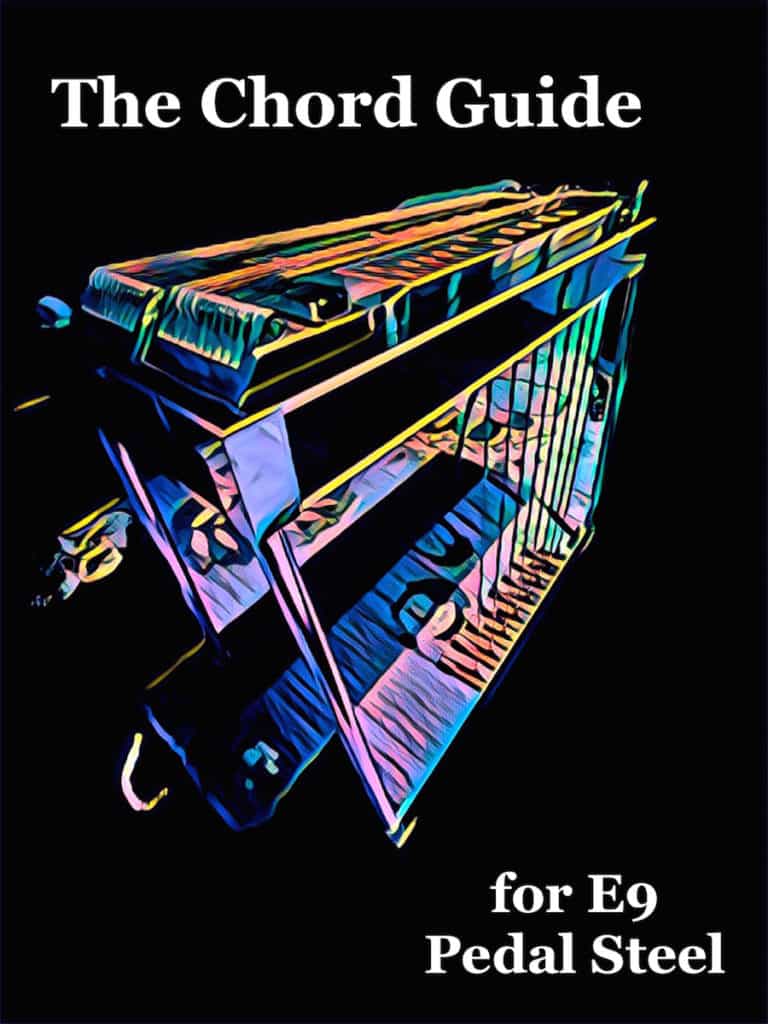
Learn the chords on the E9 neck in a way that makes playing simple and enjoyable…
- Almost Every Chord You’ll Ever Need for E9
- Intuitive and Easy to Use
- Make Use of Pedal and Lever Combinations
- Example Tabs of Chord Movements
- Easily Utilize the Nashville Number System
- Great For Any Key and Style of Music
Includes a bonus section of over a hundred pages of extra chord charts, key references, and more!
You may also like…
200 Country Riffs & Licks for E9 Pedal Steel
Add these country licks to your playing repertoire…
- Easy to Read Format
- Includes Rhythmic Notation
- Playing Over Chord Changes
- Great for Country, Alt-Country, & Honky-Tonk Styles
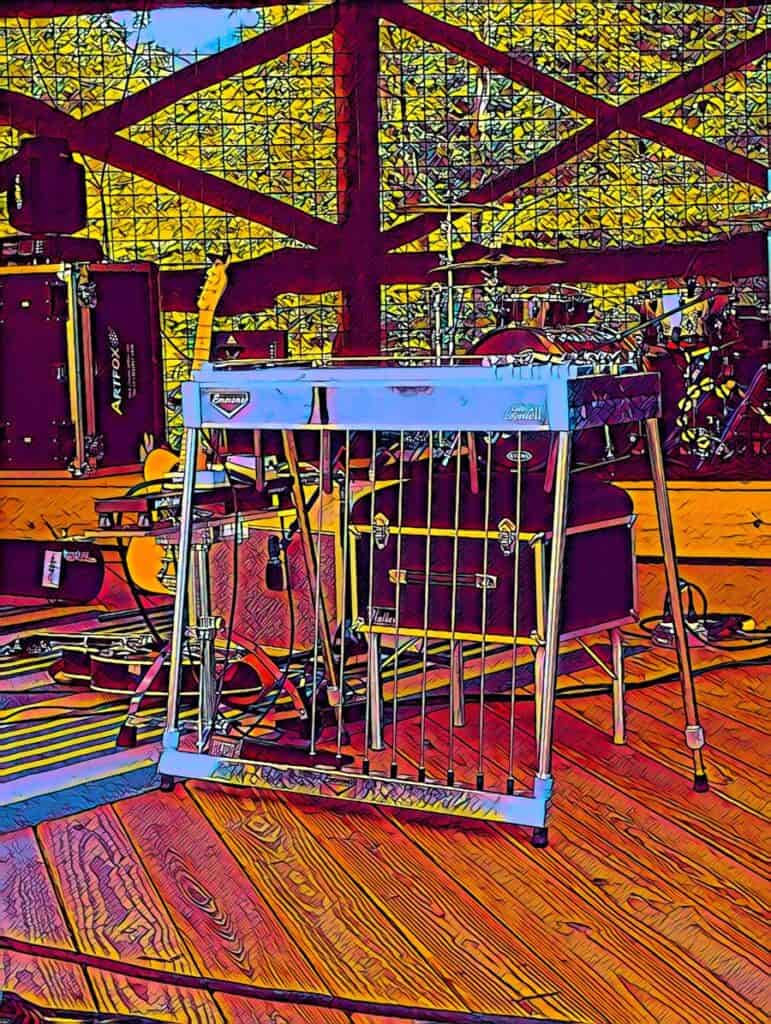

The Scale Book for E9 Pedal Steel
Over 1,000 Pages with Tabs and Diagrams!
- Easy to Use Reference for Practicing
- All Major and Minor Pentatonic Scales, Modes, Major Scales
- All Keys, and Covers the Fretboard
- Includes Pockets of Scales
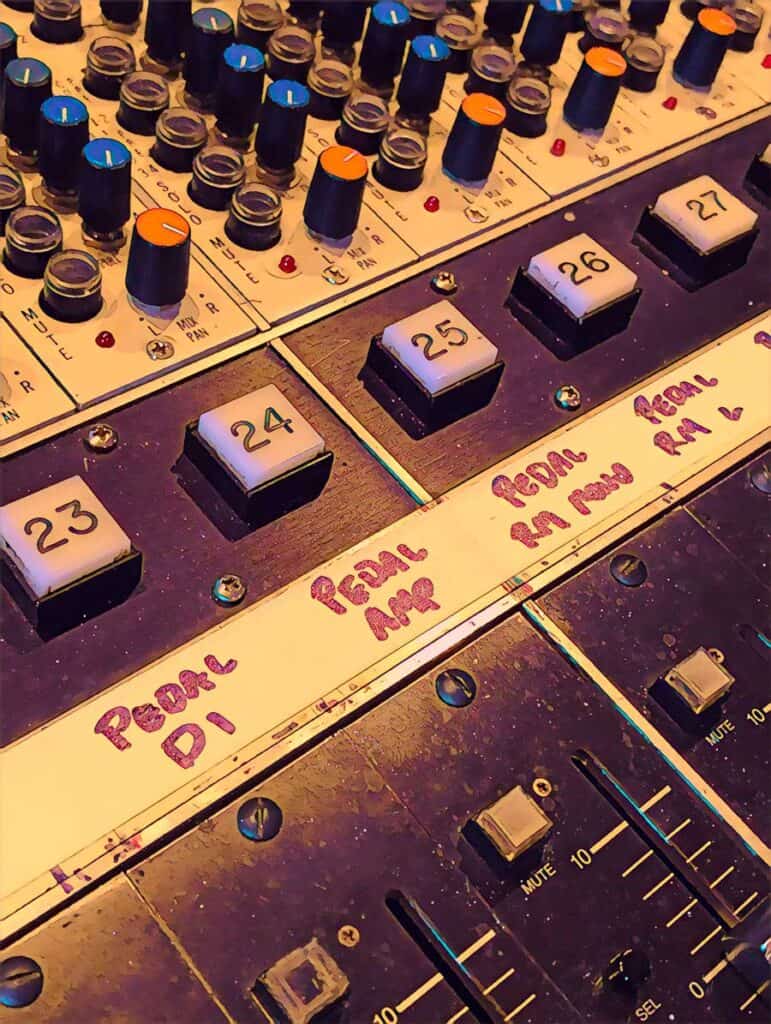
Harmonized 6ths
- Hundreds of Riffs, Licks, and More
- How To Play Sixth Intervals on the E9 Neck – Over Any Chord
- Utilizes The Pedals and Knee Levers

Right Hand Picking & Blocking
- An In-Depth Guide to Picking and Blocking
- Perfect Your Technique
- Includes Graphics, Illustrations, & Practice Exercises
For info on pedal steel tuners and tuning options, click here…
